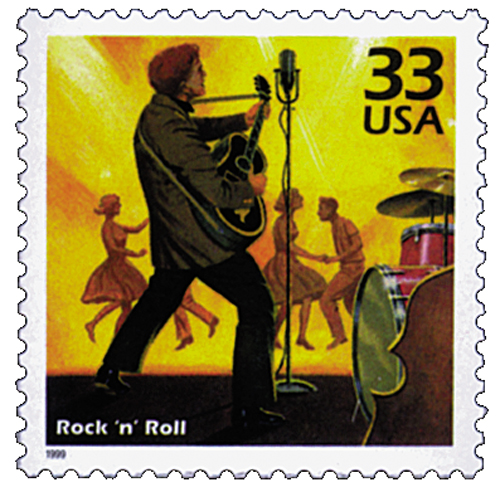
# 3187m FDC - 1999 33c Celebrate the Century - 1950s: Rock 'n' Roll
33¢ Rock ”˜n Roll
Celebrate the Century – 1950s
City: Springfield, MA
Printing Method: Lithographed, engraved
Perforations: 11.5
Color: Multicolored
First Inductees In Rock And Roll Hall Of Fame
The Rock and Roll Hall of Fame was the brainchild of businessman, Atlantic Records co-founder, songwriter, and philanthropist Ahmet Ertegun. He, Rolling Stone publisher Jann Wenner, and several record executives established the Rock and Roll Hall of Fame Foundation on April 20, 1983.

In the coming years, they began plans for the physical museum. They considered several cities with ties to rock history – New Orleans, Memphis, Chicago, San Francisco, and New York. They ultimately settled on Cleveland, Ohio, the place where disc jockey Alan Freed coined the phrase “rock and roll.”
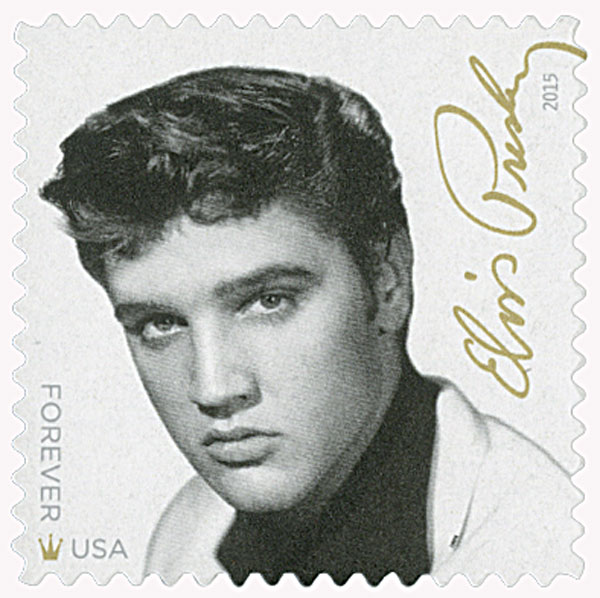
As plans for the museum progressed, the organizers wanted to start honoring rock legends. So on January 23, 1986, they held the first induction ceremony at the Waldorf-Astoria in New York City. The first inductees were all pioneers in the world of rock and roll – Chuck Berry, Elvis Presley, Little Richard, Fats Domino, Buddy Holly, the Everly Brothers, Ray Charles, James Brown, Sam Cooke and Jerry Lee Lewis.
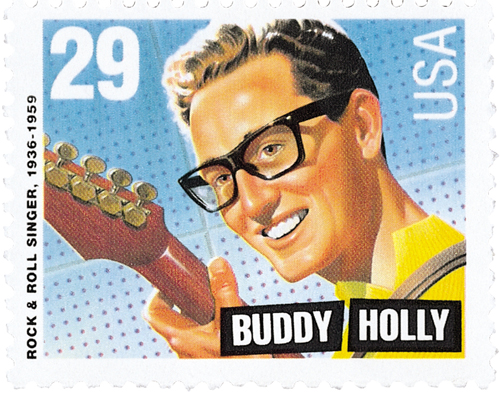
There were also non-performer inductees – Sun Records founder Sam Philips and DJ Alan Freed. The museum also inducted Early Influencers Robert Johnson, Jimmie Rogers, and Jimmy Yancey. Additionally, Columbia Records’ John Hammond, who had discovered Billie Holiday, Aretha Franklin, Bob Dylan, and Bruce Springsteen, received the museum’s first Lifetime Achievement Award.
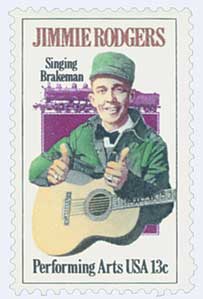
A special guest inducted each honoree. The Rolling Stones’ Keith Richards delivered a heartfelt speech about Chuck Berry; Steve Winwood honored James Brown; Quincy Jones inducted Ray Charles; Herb Alpert inducted Sam Cooke; Billy Joel honored Fats Domino; Neil Young inducted the Everly Brothers; John Fogerty honored Buddy Holly; Hank Williams, Jr., inducted Jerry Lee Lewis; Roberta Flack inducted Little Richard; and John Lennon’s sons inducted their father’s hero, Elvis Presley.
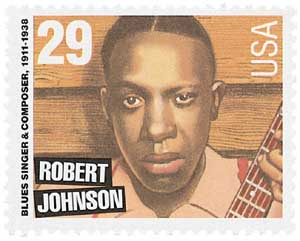
After the ceremonies, an all-star jam took over the stage with performances by the living inductees, Steve Winwood, John Fogerty, Billy Joel, and ZZ Top. They played songs by the inductees as well as other classic rock hits well into the night.
Nearly a decade later, the museum officially opened on September 2, 1995, with performances by Chuck Berry, Bob Dylan, Al Green, Jerry Lee Lewis, Aretha Franklin, Bruce Springsteen, Iggy Pop, John Fogerty, John Mellencamp, and many others. While the museum is located in Cleveland, most of the induction ceremonies (26) have been held in New York City, while two have been in Los Angeles and four in Cleveland.
Click here for more about the Rock and Roll Hall of Fame.
33¢ Rock ”˜n Roll
Celebrate the Century – 1950s
City: Springfield, MA
Printing Method: Lithographed, engraved
Perforations: 11.5
Color: Multicolored
First Inductees In Rock And Roll Hall Of Fame
The Rock and Roll Hall of Fame was the brainchild of businessman, Atlantic Records co-founder, songwriter, and philanthropist Ahmet Ertegun. He, Rolling Stone publisher Jann Wenner, and several record executives established the Rock and Roll Hall of Fame Foundation on April 20, 1983.

In the coming years, they began plans for the physical museum. They considered several cities with ties to rock history – New Orleans, Memphis, Chicago, San Francisco, and New York. They ultimately settled on Cleveland, Ohio, the place where disc jockey Alan Freed coined the phrase “rock and roll.”

As plans for the museum progressed, the organizers wanted to start honoring rock legends. So on January 23, 1986, they held the first induction ceremony at the Waldorf-Astoria in New York City. The first inductees were all pioneers in the world of rock and roll – Chuck Berry, Elvis Presley, Little Richard, Fats Domino, Buddy Holly, the Everly Brothers, Ray Charles, James Brown, Sam Cooke and Jerry Lee Lewis.

There were also non-performer inductees – Sun Records founder Sam Philips and DJ Alan Freed. The museum also inducted Early Influencers Robert Johnson, Jimmie Rogers, and Jimmy Yancey. Additionally, Columbia Records’ John Hammond, who had discovered Billie Holiday, Aretha Franklin, Bob Dylan, and Bruce Springsteen, received the museum’s first Lifetime Achievement Award.

A special guest inducted each honoree. The Rolling Stones’ Keith Richards delivered a heartfelt speech about Chuck Berry; Steve Winwood honored James Brown; Quincy Jones inducted Ray Charles; Herb Alpert inducted Sam Cooke; Billy Joel honored Fats Domino; Neil Young inducted the Everly Brothers; John Fogerty honored Buddy Holly; Hank Williams, Jr., inducted Jerry Lee Lewis; Roberta Flack inducted Little Richard; and John Lennon’s sons inducted their father’s hero, Elvis Presley.

After the ceremonies, an all-star jam took over the stage with performances by the living inductees, Steve Winwood, John Fogerty, Billy Joel, and ZZ Top. They played songs by the inductees as well as other classic rock hits well into the night.
Nearly a decade later, the museum officially opened on September 2, 1995, with performances by Chuck Berry, Bob Dylan, Al Green, Jerry Lee Lewis, Aretha Franklin, Bruce Springsteen, Iggy Pop, John Fogerty, John Mellencamp, and many others. While the museum is located in Cleveland, most of the induction ceremonies (26) have been held in New York City, while two have been in Los Angeles and four in Cleveland.
Click here for more about the Rock and Roll Hall of Fame.






